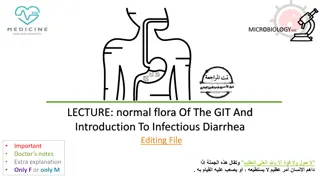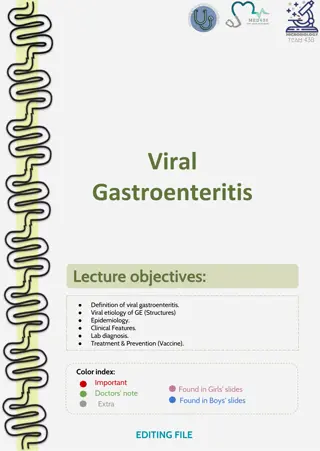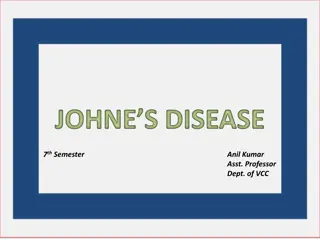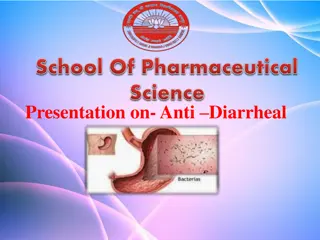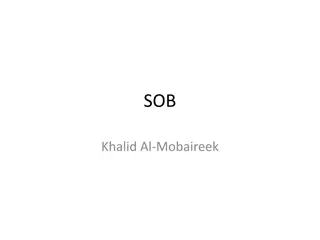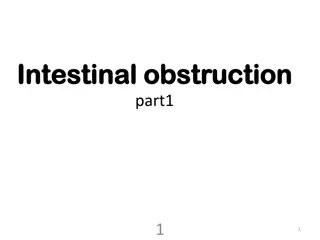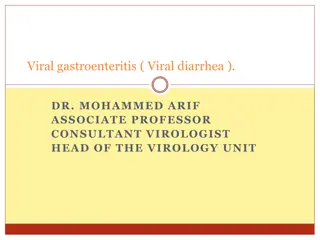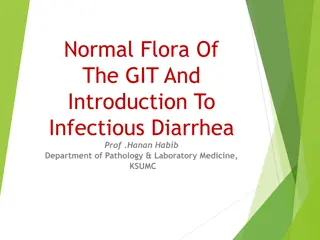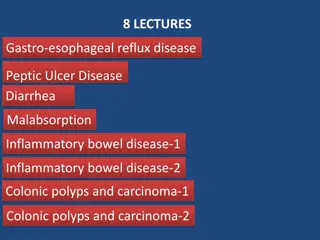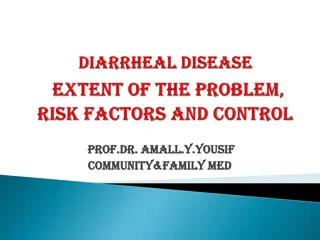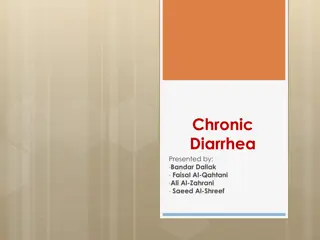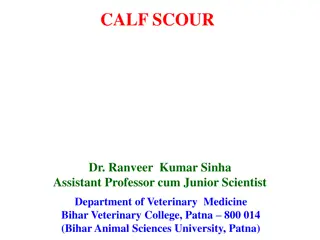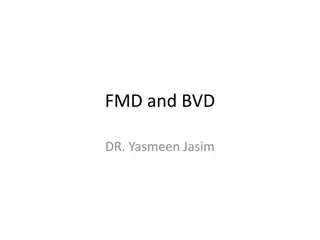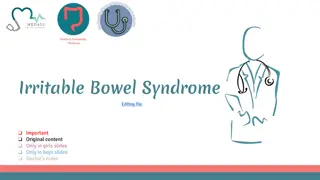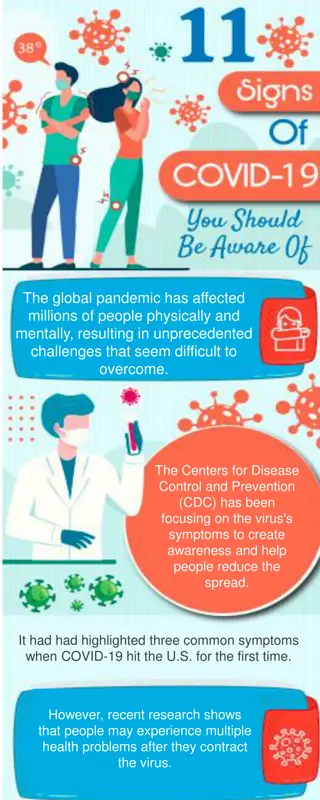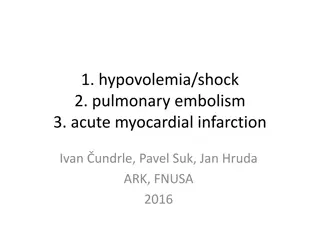Understanding Diarrhea: Causes, Symptoms, and Pathophysiology
Diarrhea is a common symptom that can be caused by various factors such as viral, bacterial, parasitic infections, dietary changes, drugs, systemic diseases, and intestinal obstructions. It can lead to dehydration and other serious complications if not treated promptly. The pathophysiology of diarrhea involves mechanisms like osmotic diarrhea, which occurs with malabsorptive disorders and dietary indiscretion. Recognizing the underlying cause is essential for appropriate management.
Download Presentation

Please find below an Image/Link to download the presentation.
The content on the website is provided AS IS for your information and personal use only. It may not be sold, licensed, or shared on other websites without obtaining consent from the author. Download presentation by click this link. If you encounter any issues during the download, it is possible that the publisher has removed the file from their server.
E N D
Presentation Transcript
Diarrhea can be defined as increased fecal fluidity, usually accompanied by increased defecation frequency and volume of feces. It could be acute when lasting for less than 14 days or might be chronic if it lasting for more than 14 days and more. The most common accompanying features of diarrhea include Vomiting, Dehydration, Loss of appetite, Abdominal pain ,Fever, Lethargy, and Bloody and/or watery diarrhea
Diarrhea Its not a disease but a symptom of many different diseases. Many mild cases of diarrhea can be resolved quickly with simple treatments. However, others are the result of serious or life- threatening illnesses such as cancer. Even diarrhea caused by mild illnesses may become fatal if treatment is not begun early enough to prevent severe fluid and nutrient losses.
The most important causes of diarrhea are 1-Viral infection such as Canine parvovirus Corona virus 2-Bacterial infection such as Campylobacter species Clostridium difficile toxins A/B Clostridium perfringens enterotoxin enteropathogenic E coli Salmonella species Yersinia species
3-Parasitic infection such as Coccidian and / Cryptosporidium species Giardia and Toxocara hookworms, roundworms, and whipworms 4-Diet causes chemicals and toxins Diet change (such as a change in diet or eating garbage or other offensive or irritating materials) Foreign material Plants
5-Drugs 6-Systemic Diseases such as Acute liver disease Acute pancreatitis Acute renal failure (leptospirosis) canine distemper hypoadrenocorticism 7-Intestinal Obstruction .such as Foreign body Intestinal accident Intussusception Antibiotics cancer chemotherapeutics copper chelators corticosteroids Digoxin Magnesium antacids nonsteroidal anti- inflammatory drugs
Pathophysiology.. Four major pathophysiologic mechanisms can cause diarrhea Osmotic diarrhea: Osmotic diarrhea occurs with many malabsorptivedisorders, such as exocrine pancreatic insufficiency, in which poorly digested nutrients are malabsorbed, remain within the GI lumen, and attract water. It can also occur with overeating and dietary indiscretion if poorly absorbed nutrients are ingested.
2-Secretory diarrhea: Stimulation of crypt enterocytes results in secretion of large volumes of fluid that exceeds the absorptive ability of the intestine. This occurs most commonly with infectious diseases, such as enteropatho- genic Escherichia coli and salmonellosis, meaning when inflammatory bowel disease will occur. 3-Increased mucosal permeability: Increased permeability of the intestinal mucosa causes loss of fluids, electrolytes, proteins, and blood into the intestinal lumen. It commonly accompanies erosive, ulcerative, neoplastic (intestinal lymphoma), and sever inflammatory processes, and mostly worm infection.
4-Abnormal motility: Abnormal motility is often secondary to disorders that cause diarrhea. Decreased segmental contractions result in transport of ingesta at a rate too fast for normal digestion and absorption. Generally diarrhea can cause Profound dehydration, Hypovolemicshock, Electrolyte abnormalities (hypokalemia, hypochloremia, and hyponatremia), and acid base disturbances. Metabolic acidosis
The common clinical signs include Moderate to severe dehydration Abdominal pain Depression Melena or hematochezia Presence of an abdominal mass or dilated loop of bowel Frequent vomiting Signs of systemic illness, such as: Ascites Lymphadenopathy coughing , ocular and nasal discharge hepatomegaly oliguria/anuria Icterus Pyrexia
Hemorrhagic gastroenteritis (HGE) Is a diarrheal syndrome of unknown etiology that has a predilection for small breed dogs; it has not been reported in cats. Speculation regarding pathogenesis includes type-1 hypersensitivity reaction to food components, and C difficile toxins A/B. HGE is distinctively characterized by peracute onset of bloody diarrhea and vomiting accompanied by marked hemoconcentration. Packed cell volume of an affected dog can reach 75% or higher within hours of onset of signs, yet total plasma protein often remains within reference range.
Symptomatic therapy, primarily IV fluid therapy and gastroprotectants, results in marked clinical improvement within 24 to 48 hours. Antimicrobial therapy is usually administered, although in a recent study, clinical response was not improved in dogs that received antibiotics (amoxicillin/clavulanicacid). with appropriate therapy, mortality is low despite severity of signs.
Treatment . It include 1-Nutritional management: a-Animals with acute diarrhea often benefit from withholding food for 6 to 12 hours followed by frequent (3 6 small meals/day) feeding of small amounts of a highly digestible, so-called bland, diet; amount fed per meal can be slowly increased. b- such diets for dogs should have a low or modest fat content c- Useful choices include boiled rice with lean chicken, low- fat cottage cheese, Moreover, high fiber diet should recommended. 2-Therapeutic deworming A suitable antiparasiticide should be prescribed. Fenbendazole 50 mg/kg Po Q 24 h for 3 5 days
3-Antidiarrheal agents The ideal anti-diarrhea should contain the following -Non or less absorbable anti biotic and/or anti microbial therapy -Intestinal adsorbent agent (bactin and kaolin) -Vit. A to restore the intestinal mucosa Diphenoxylate (Lomotil) Dogs: 0.05 0.2 mg/kg Po Q 6 8 h *Cats: 0.08 0.1 mg/kg Po Q 12 h Loperamide (Imodium) Dogs: 0.08 0.2 mg/kg Po Q 6 12 h *Cats: 0.04 mg/kg Po Q 12 24 h
4- Antiemetic Metoclopramide( plasil ) 0.2 05 mg/kg i.m., s.c., p.o. q6 8h or 1 2 mg/kg Dyphenhydramine 4 mg / animal orally 5-Probiotic They are live microorganisms that, when administered in adequate amounts, confer a health benefit on the host Pro- biotics include a wide variety of organisms, such as various species of Lactobacillus, Bifidobacter, Bacillus, E coli, Streptococcus, and Saccharomyces. 6-Antimicrobial (selected cases) Metronidazole Dogs: 10-15 mg/kg Po Q 12 h Cats: 62.5 mg Po Q 12 h Tylosin 10 15 mg/kg Po Q 12 24 h Amoxicillin-clavulanic acid 12.5 22 mg/kg Po Q 12 h Ampicillin 22 mg/kg Po Q 8 12 h 7- Fluid therapy.


